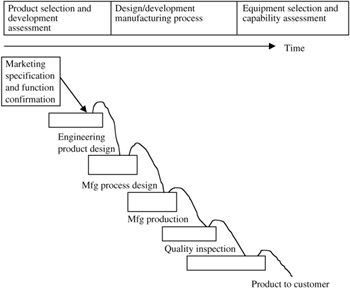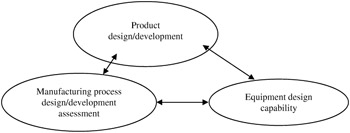BUSINESS EXPECTATIONS AND THE IMPACT FROM A SUCCESSFUL DFMDFA
BUSINESS EXPECTATIONS AND THE IMPACT FROM A SUCCESSFUL DFM/DFA
Perhaps one of the major reasons why we do a DFMA is that in the final analysis we expect tremendous results with a measurable impact in the organization. Typical expectations are:
-
Product development time improvement by 50 “75%
-
Product design cost reduction by 25 “50%
-
Product liability improvement by 10 “25%
-
Product field performance chosen to customer's needs/wants
-
Product production launch time reduction by 25 “50%
-
Total manufacturing cost reduction by 25 “75%
-
Reduction or even elimination of additional tooling/fixture cost
-
Reduction, if not total elimination, of the engineering change notice by 75 “99%
-
Increase in engineering and technical personnel's work morale , and also letting them feel and assume ownership
-
Ability to be competitive, be profitable, be successful
The impact, of course, becomes obvious. The entire organization is impacted for the better ” it becomes business focused. For example: marketing becomes focused on the customer; engineering becomes focused on design; and manufacturing becomes focused on process. Specifically, the impact may be in the following areas:
-
Product closer to what customer expects
-
Reduction of time to market
-
Enhanced product liability, not just from original product design point of view but also from a manufacturing process point of view
-
Improved profit margins by reducing product cost
-
Improved operating efficiency by reducing work-in-process
-
Enhanced return on assets
-
Reduced technical personnel turnover rate by improving group and individual satisfaction with the job/work
-
Making the organization be profitable
Traditional Approach ” In the past, product design/development, manufacturing process design/development, and equipment selection/capability assessment were typically discrete activities ” a sequential and discrete approach. That approach may be shown as in Figure 5.2.

Figure 5.2: Sequential approach.
New Way ” In order to let the manufacturing process and equipment have a head start, all three activities of design, process, and equipment occur simultaneously ” a simultaneous equipment approach. This is where DFMA can help. This process may be shown as in Figure 5.3.

Figure 5.3: Simultaneous approach.
The business strategy here becomes a pursuit to articulate the:
Customer needs, wants and expectations ’ product/process engineering specification
by asking a series of specific questions such as:
-
What is the voice of the customer (VOC)?
-
What regulations have to be met?
-
What is the relative importance of requirement?
-
Which product characteristics impact the VOC?
-
Which process characteristics impact the VOC?
-
What price and profit margin impact to meet VOC?
-
Are there delivery schedule impacts?
-
Any competition? Targeted competitor?
-
Continuing improvement opportunity?
-
Future cost reduction opportunity to meet future customer price reduction demands?
Figure 5.4 shows the modern way of addressing these concerns. The arrows between product and process indicate possible alternatives. For example, if we examine the producibility for a textile component, we could look at the following material considerations:
-
Natural
-
Synthetic
-
Properties
-
Processes
-
Applications

Figure 5.4: Tomorrow's approach ... if not today's.
On the other hand, if we were to evaluate the manufacturing process we might want to examine:
-
Pattern layout
-
Cutting
-
Sewing assembly
-
Types
-
Processes
-
Characteristics
EAN: 2147483647
Pages: 235